Theoretical Paper
- Computer Organization
- Data Structure
- Digital Electronics
- Object Oriented Programming
- Discrete Mathematics
- Graph Theory
- Operating Systems
- Software Engineering
- Computer Graphics
- Database Management System
- Operation Research
- Computer Networking
- Image Processing
- Internet Technologies
- Micro Processor
- E-Commerce & ERP
Practical Paper
Industrial Training
OSI Architecture
iso-osi 7-layer network architecture
this lecture introduces the iso-osi layered architecture of networks. according to the iso standards, networks have been divided into 7 layers depending on the complexity of the fucntionality each of these layers provide. the detailed description of each of these layers is given in the notes below. we will first list the layers as defined by the standard in the increasing order of function complexity:
- physical layer
- data link layer
- network layer
- transport layer
- session layer
- presentation layer
- application layer
physical layer
this layer is the lowest layer in the osi model. it helps in the transmission of data between two machines that are communicating through a physical medium, which can be optical fibres,copper wire or wireless etc. the following are the main functions of the physical layer:- hardware specification: the details of the physical cables, network interface cards, wireless radios, etc are
a part of this layer.

- encoding and signalling: how are the bits encoded in the medium is also decided by this layer. for example,
on the coppar wire medium, we can use differnet voltage levels for a certain time interval to represent '0' and '1'.
we may use +5mv for 1nsec to represent '1' and -5mv for 1nsec to represent '0'. all the issues of modulation is dealt
with in this layer. eg, we may use binary phase shift keying for the representation of '1' and '0' rather than using
different volatage levels if we have to transfer in rf waves.
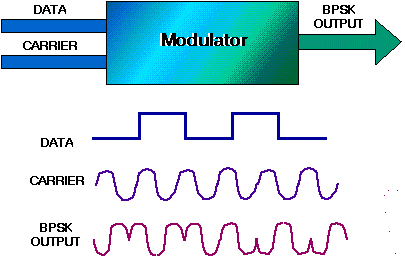
binary phase shift keying
- data transmission and reception: the transfer of each bit of data is the responsibility of this layer. this layer assures the transmissoin of each bit with a high probability. the transmission of the bits is not completely reliable as their is no error correction in this layer.
- topology and network design: the network design is the integral part of the physical layer. which part of the
network is the router going to be placed, where the switches will be used, where we will put the hubs, how many machines
is each switch going to handle, what server is going to be placed where, and many such concerns are to be taken care
of by the physical layer. the variosu kinds of netopologies that we decide to use may be ring, bus, star or a hybrid of
these topologies depending on our requirements.
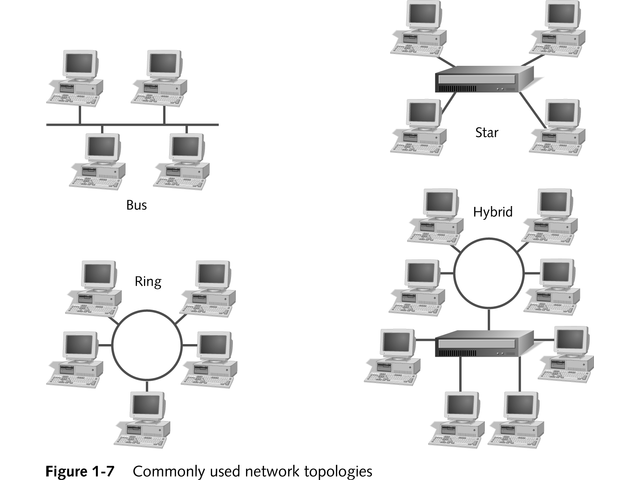
data link layer
this layer provides reliable transmission of a packet by using the services of the physical layer which transmits bits over the medium in an unreliable fashion. this layer is concerned with :- framing : breaking input data into frames (typically a few hundred bytes) and caring about the frame boundaries and the size of each frame.
- acknowledgment : sent by the receiving end to inform the source that the frame was received without any error.
- sequence numbering : to acknowledge which frame was received.
- error detection : the frames may be damaged, lost or duplicated leading to errors.the error control is on link to link basis.
- retransmission : the packet is retransmitted if the source fails to receive acknowledgment.
- flow control : necessary for a fast transmitter to keep pace with a slow receiver.
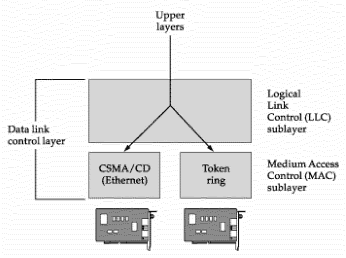
data link layer
network layer
its basic functions are routing and congestion control.routing: this deals with determining how packets will be routed (transferred) from source to destination. it can be of three types :
- static : routes are based on static tables that are "wired into" the network and are rarely changed.
- dynamic : all packets of one application can follow different routes depending upon the topology of the network, the shortest path and the current network load.
- semi-dynamic : a route is chosen at the start of each conversation and then all the packets of the application follow the same route.
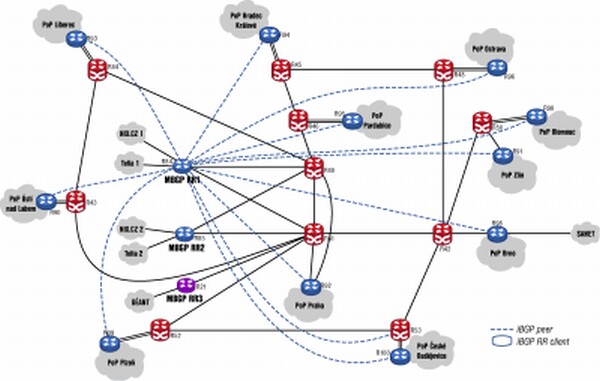
routing
the services provided by the network can be of two types :
- connection less service: each packet of an application is treated as an independent entity. on each packet of the application the destination address is provided and the packet is routed.
- connection oriented service: here, first a connection is established and then all packets of the application follow the same route. to understand the above concept, we can also draw an analogy from the real life. connection oriented service is modeled after the telephone system. all voice packets go on the same path after the connection is established till the connection is hung up. it acts like a tube ; the sender pushes the objects in at one end and the receiver takes them out in the same order at the other end. connection less service is modeled after the postal system. each letter carries the destination address and is routed independent of all the others. here, it is possible that the letter sent first is delayed so that the second letter reaches the destination before the first letter.
internetworking: internetworks are multiple networks that are connected in such a way that they act as one large network, connecting multiple office or department networks. internetworks are connected by networking hardware such as routers, switches, and bridges.internetworking is a solution born of three networking problems: isolated lans, duplication of resources, and the lack of a centralized network management system. with connected lans, companies no longer have to duplicate programs or resources on each network. this in turn gives way to managing the network from one central location instead of trying to manage each separate lan. we should be able to transmit any packet from one network to any other network even if they follow different protocols or use different addressing modes.
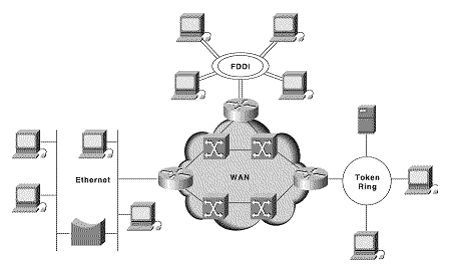
inter-networking
network layer does not guarantee that the packet will reach its intended destination. there are no reliability guarantees.
transport layer
its functions are :- multiplexing / demultiplexing : normally the transport layer will create distinct network connection for each transport connection required by the session layer. the transport layer may either create multiple network connections (to improve throughput) or it may multiplex several transport connections onto the same network connection (because creating and maintaining networks may be expensive). in the latter case, demultiplexing will be required at the receiving end. a point to note here is that communication is always carried out between two processes and not between two machines. this is also known as process-to-process communication.
- fragmentation and re-assembly : the data accepted by the transport layer from the session layer is split up into smaller units (fragmentation) if needed and then passed to the network layer. correspondingly, the data provided by the network layer to the transport layer on the receiving side is re-assembled.
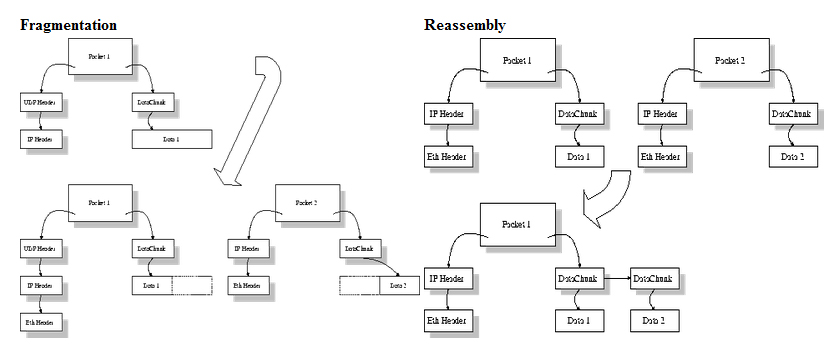
- types of service : the transport layer also decides the type of service that should be provided to the session layer. the service may be perfectly reliable, or may be reliable within certain tolerances or may not be reliable at all. the message may or may not be received in the order in which it was sent. the decision regarding the type of service to be provided is taken at the time when the connection is established.
- error control : if reliable service is provided then error detection and error recovery operations are also performed. it provides error control mechanism on end to end basis.
- flow control : a fast host cannot keep pace with a slow one. hence, this is a mechanism to regulate the flow of information.
- connection establishment / release : the transport layer also establishes and releases the connection across the network. this requires some sort of naming mechanism so that a process on one machine can indicate with whom it wants to communicate.
Physical layer in the OSI model plays the role of interacting with actual hardware and signaling mechanism. Physical layer is the only layer of OSI network model which actually deals with the physical connectivity of two different stations. This layer defines the hardware equipment, cabling, wiring, frequencies, pulses used to represent binary signals etc.
Physical layer provides its services to Data-link layer. Data-link layer hands over frames to physical layer. Physical layer converts them to electrical pulses, which represent binary data.The binary data is then sent over the wired or wireless media.
Signals
When data is sent over physical medium, it needs to be first converted into electromagnetic signals. Data itself can be analog such as human voice, or digital such as file on the disk.Both analog and digital data can be represented in digital or analog signals.
Digital Signals
Digital signals are discrete in nature and represent sequence of voltage pulses. Digital signals are used within the circuitry of a computer system.
Analog Signals
Analog signals are in continuous wave form in nature and represented by continuous electromagnetic waves.
Transmission Impairment
When signals travel through the medium they tend to deteriorate. This may have many reasons as given:
Attenuation
For the receiver to interpret the data accurately, the signal must be sufficiently strong.When the signal passes through the medium, it tends to get weaker.As it covers distance, it loses strength.
Dispersion
As signal travels through the media, it tends to spread and overlaps. The amount of dispersion depends upon the frequency used.
Delay distortion
Signals are sent over media with pre-defined speed and frequency. If the signal speed and frequency do not match, there are possibilities that signal reaches destination in arbitrary fashion. In digital media, this is very critical that some bits reach earlier than the previously sent ones.
Noise
Random disturbance or fluctuation in analog or digital signal is said to be Noise in signal, which may distort the actual information being carried. Noise can be characterized in one of the following class:
Thermal Noise
Heat agitates the electronic conductors of a medium which may introduce noise in the media. Up to a certain level, thermal noise is unavoidable.
Intermodulation
When multiple frequencies share a medium, their interference can cause noise in the medium. Intermodulation noise occurs if two different frequencies are sharing a medium and one of them has excessive strength or the component itself is not functioning properly, then the resultant frequency may not be delivered as expected.
Crosstalk
This sort of noise happens when a foreign signal enters into the media. This is because signal in one medium affects the signal of second medium.
Impulse
This noise is introduced because of irregular disturbances such as lightening, electricity, short-circuit, or faulty components. Digital data is mostly affected by this sort of noise.
Transmission Media
The media over which the information between two computer systems is sent, called transmission media. Transmission media comes in two forms.
Guided Media
All communication wires/cables are guided media, such as UTP, coaxial cables, and fiber Optics. In this media, the sender and receiver are directly connected and the information is send (guided) through it.
Unguided Media
Wireless or open air space is said to be unguided media, because there is no connectivity between the sender and receiver. Information is spread over the air, and anyone including the actual recipient may collect the information.
Channel Capacity
The speed of transmission of information is said to be the channel capacity. We count it as data rate in digital world. It depends on numerous factors such as:
Bandwidth: The physical limitation of underlying media.
Error-rate: Incorrect reception of information because of noise.
Encoding: The number of levels used for signaling.
Multiplexing
Multiplexing is a technique to mix and send multiple data streams over a single medium. This technique requires system hardware called multiplexer (MUX) for multiplexing the streams and sending them on a medium, and de-multiplexer (DMUX) which takes information from the medium and distributes to different destinations.
Switching
Switching is a mechanism by which data/information sent from source towards destination which are not directly connected. Networks have interconnecting devices, which receives data from directly connected sources, stores data, analyze it and then forwards to the next interconnecting device closest to the destination.
Switching can be categorized as:


